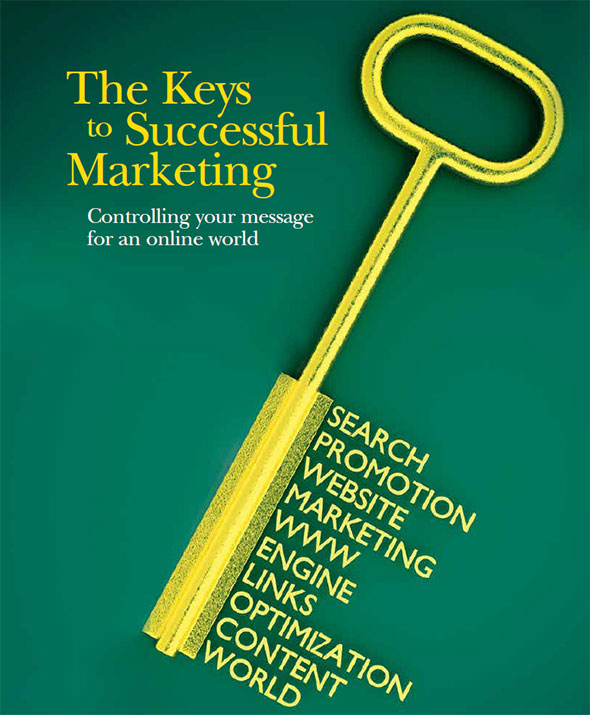
You’d expect a marketing professional to have a way with words, and Tommy Redmond, president of Octane Marketing Solutions, does not disappoint. “You can be great at your business in every way, but if you don’t have a good Web presence, it’s like showing up at your senior prom in a T-shirt with spaghetti stains on it,” says Redmond, who founded the Marietta-based marketing company two and a half years ago.
Octane numbers as one of several Cobb County-based marketing companies that works to help their clients tailor a message for 21st century business. “It used to be that marketing was limited to four areas: newspapers, the Yellow Pages, radio and television. With the advent of today’s digital world, we want to make sure our clients are fully represented on all the new areas out there,” says Redmond.
While well-positioned billboards and other old-school marketing techniques can still bring results, today’s high-tech landscape can require some new strategies.
Research. A crucial aspect of successful marketing occurs before any of the actual marketing takes place. “Most businesses fail in the first two years. You might have a great idea, but not everyone else may agree,” says Heather Pennington, president and CEO of Kennesaw’s Day Three Media. “With market research, you can make sure everyone else thinks it’s a great idea, too.”
Gordon O’Neill, CEO and chief integration strategist of O’Neill Communications, points out that the World Wide Web makes research easier and more accessible than ever before. “Today’s Internet allows even the smallest company to conduct its own research, and inexpensive research tools are out there.”
Angelia Pressley, managing partner of Smyrna’s AP Advertising and PR, explains how computerized tracking methods allow big companies to amass data and craft highly specific messages to their customers. “[The Internet] creates an opportunity to build demographics about a customer,” says Pressley. “If I’m online at AT&T or Comcast, advertisers can see where I’m going through my IP address and click back to me with an ad. Whether I’m looking for shoes, a new car or a wedding gown, they’ll know immediately.”
Small companies can use the same kind of tools to gather information about their clients and send them highly-focused messages. “A small retailer can build a customer email list to remind them of upcoming sales, service packaging offers, new classes and more,” says O’Neill. “It’s very instrumental in building a relationship, and it’s easy and inexpensive to maintain.”
The Website. Marketers almost speak in a single voice about the importance of a company’s web presence in today’s environment. “As all roads lead to Rome, now all roads lead to your website, whether it’s on a PC platform or, increasingly, on mobile platforms,” says Redmond.
Just as prospective romantic partners Google each other before getting together, so do prospective business partners. “After people meet you, the first thing they do is look at your website. It’s very important that the first three to five seconds make a good impression,” says Pennington. “Websites need to be aesthetically pleasing to the eye and Google friendly.”
The failure to maintain your website can be nearly as harmful as the failure to have one. “You should revisit your website at least once a year, asking questions like, ‘What changes have gone through the marketplace since then?’” says Pennington. “There’s nothing worse than going to a website, Facebook or LinkedIn page and finding it out of date.”
Marketing began migrating to the Internet in the late 1990s, but more recently, video elements have become increasingly prevalent in online messaging. “Society is moving toward video, and people are using it for business decisions,” says Pennington. “Your website should have a corporate video that sums up your elevator pitch: who you are, what you can offer, etc.”
Pennington describes how Day Three Media helped CBE, an Alabama-based point-of-sale and security product company, to keep pace with the times. “They’ve been around for 20 years and their website was eight or nine years old. They thought, ‘We’re very successful—why should we change anything?’” Pennington recalls. “We helped them look like what they should look like, if they’re competing in an up-to-date marketplace.”
Social Media. The term “Web 2.0” frequently serves as shorthand for the proliferation of social media platforms such as Facebook, Twitter and others. “It’s so easy to do and so accessible, it’s easy to do wrong,” says Bonnie Buckner Reavis of Marietta’s Zenith Design Group, who points out how social networking’s simplicity can cause business owners to underestimate its impact. “Social media is one of the best ways to increase awareness, fairly inexpensively. A lot of companies will put an administrative person in charge of social media, but more people will see what that person is saying than will visit the company’s website.”
Simply having a presence on social media is only half of the job. “Everything needs to be written in a tone that could be printed on brochure or written for the website. One post written in the wrong tone or not vetted properly can undo a year’s worth of marketing,” says Reavis, who emphasizes that posts can’t be too impersonal, either. “You have to post as if the brand is a person, having a one-on-one dialogue. It needs to be casual and conversational. And if multiple people are maintaining the Facebook site, it still needs to have a single voice.”
Reavis finds that Facebook in particular lends itself to connecting with present and future customers, as opposed to one-way messaging. “Tweets are just statements, so not a lot of dialogue comes with them. People are comfortable on Facebook, which promotes dialogue.” Reavis advocates cultivating Facebook interactions as an ongoing process. “You need to monitor Facebook … It requires maintenance and someone to watch it, and not just from 8 a.m. to 5 p.m.”
Branding. William Musial, creative director of Kennesaw design and branding studio Mopdog, learned a crucial lesson in branding from his own company. He incorporated as William Musial Advertising about 22 years ago, when the Internet was in its infancy. When it came time to choose a domain name, the company went with “Mopdog.com” after his two shaggy Shih Tzus. And Mopdog turned out to have legs.
“Those six letters changed our entire marketing and branding message. Nobody remembered the name ‘William Musial Advertising,’ but everyone remembered ‘Mopdog,’” says Musial. “My email was ‘topdog@mopdog,’ and people remembered that better than my own name.” Essentially, his customers told him which name and image proved most effective, demonstrating the importance of simple, flexible branding. Now, canine imagery romps playfully all over the Mopdog website.
Musial and other marketers frequently manage their clients’ brands to make them come across as leaders or experts in their respective industries. He cites as an example Mopdog’s client The Corridor Group, which specializes in home care and hospice consulting. “Over the last two years, we’ve really gotten them onto social media, talking about themselves and using HTML emails to promote their products,” he says. “Because of these things, they’ve gotten the reputation for being experts in their field.”
The Basics. Despite the dislocations of the rise of the Internet and the recent economic slump, old-fashioned face-to-face interactions still pay dividends. “The landscape is different. Because of the recession, people are value-driven. Large corporate companies scaled down their marketing dollars,” says Pressley. “But business has picked up [for] our events, which can provide a broader reach for fewer dollars.”
Pennington affirms the importance of trade shows and other events for maintaining an active presence in your community. “Sometimes it’s hard to measure ROI for events, but if you look at the long haul, the more you’re in the community, the more you build relationships, the better,” she says. “It’s easy to text and email, but personal connections still are very valuable.”
Companies who deal with a daily flood of email and other online communiqués might be more responsive to something tangible. “Really targeted direct mail is working as well as, if not better than, email,” says Musial. “It might be that email is overused. People get so many emails, they don’t read them all anymore, so people will respond to a really good piece of direct mail.”
Redmond points out how the personal touch can be lost to companies who outsource marketing services. “One of the biggest problems we see is outsourcing things overseas. We have our feet on the ground in local communities. You might find things that have been outsourced don’t speak to your local demographic. Then it’s like Bill Murray— ‘Lost in Translation.’”
Many of the companies that survived the economic downturn were able to adapt to changing times. Zenith Design Group helped landscaping company High Grove Partners take advantage of the economic slump. “They came to us and said that they wanted to take advantage of the fact that a lot of their competition had dropped off,” says Reavis. “We kept their logo but otherwise did completely new branding, with a new website and re-wrapped trucks. It’s not like we had a magic bullet, but we told them how to take advantage of depressed economy, because they had the capital to reinvest.”
For some companies, adaptation can mean playing to strengths outside a narrow definition of its brand. As Redmond explains, “We work with a local Goodyear dealership in East Cobb, and restructured their brand not only to emphasize what they do with tires, but also their service department, which was actually a major part of their business. We took them from zero visibility in the search engines and branded them in an extremely different way.”
Finally, it’s important that companies don’t jump the gun when they send out their message. “We only want to work with clients who have a product they’re ready to go to market with,” says Reavis. “Nothing will kill a good company quicker than great marketing without a product to support it.”
To borrow Redmond’s analogy, that’s like showing up at your senior prom in spotless, perfectly-tailored formalwear, only to discover that you’re a week early.

















